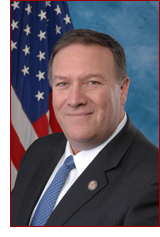October 2012: Government Affairs
Words: Dan Kamys
Government Affairs
 By Congressman Mike Pompeo (Kansas)
By Congressman Mike Pompeo (Kansas)
Energy costs are woven through the entire fabric of our economy. As a former small business owner, I understand this very well. For a small business operating on razor-thin margins, a 1 or 2 percent increase in electricity and gas prices is the difference between staying in the black or going in the red. It’s the difference between hiring or laying off staff. It’s a key ingredient in the cost of every good and service. Knowing that, you would think every policymaker in Washington, D.C., would appreciate the need for an abundant supply of affordable energy.
Unfortunately, you don’t see affordability enter the discussion when President Obama talks about energy policy. He talks about clean, alternative and renewable. You never hear him use the word “affordable.” That should concern every American, especially small business owners and manufacturers.
In fact, too much of our energy discussion today is dominated by catch phrases like “all of the above,” and “green energy.” These poll-tested catch phrases ignore a fundamental truth about the state of America’s domestic energy supply: It’s cheap, reliable, and we have plenty of it. So why is smart national energy policy so difficult to implement?
It isn’t. Here is what commonsense energy policy should look like: Allow for the exploration and use of the cheapest, most abundant forms of energy free from government intervention. It seems simple enough, but like anything in Washington, this idea gets bogged down by entrenched special interests with very specific agendas.
For decades, members of both political parties have often embraced a completely different vision, one that looks to the federal government to manipulate energy production and consumption. Examples include mileage standards for automobiles, renewable fuel blending requirements, and massive taxpayer subsidies for renewable and alternative energy. The result of this endeavor: Gas prices are now near a record high, nearing $3.90 per gallon, driven by $90 per barrel oil, and average household electricity costs have increased for five consecutive years faster than inflation.
Much of this trend is driven by the elephant in the room: the Environmental Protection Agency (EPA). The EPA has been the single-most destructive government agency during the last four years. Its overriding purpose appears to be to eliminate affordable fossil fuels in favor of high-cost renewables. Its bevy of regulations – from greenhouse gas restrictions to multiple utility regulations – aims to take fossil fuels off the table of our energy discussion. It’s an out-of-control agency, rebuked multiple times by federal courts, aimed at setting energy policy rather than environmental policy. Of course everybody wants clean air and clean drinking water, and we should all strive to be better stewards of the Earth. But that is clearly not EPA’s agenda.
Congress can change the current course of action with sensible energy policy. Energy policy aimed at reducing costs must be based on one key principle: Government bureaucrats do not have the answer to lowering gas and electricity prices. Putting that principle into action, we can come up with a sensible approach. We can rein in EPA and repeal its numerous regulations aimed at killing coal and manipulating Americans’ energy use. We can prohibit the government from picking winners and losers in the energy markets, allowing solar, wind, ethanol and other forms of energy to compete on their own terms. We can stop this Administration’s ever-louder drumbeat toward federal regulation of hydraulic fracturing, a decades-old, safe technology that has yielded the shale boom and the potential for the largest domestic manufacturing expansion in a century.
A market-based approach to energy policy that embraces ingenuity and rejects the notion that the federal government knows best seems like common sense. It is also a vast departure from what we, as a nation, are accustomed to. But with energy costs rising and the economy struggling, American businesses and consumers simply cannot afford the federal government’s business-as-usual agenda anymore.
Mike Pompeo was elected to the 112th Congress on November 2, 2010. Mike has a deep commitment to limited government, freedom, individual responsibility, and rewarding earned success. He serves on the Energy and Commerce committee, the oldest committee in the House, which has jurisdiction over nearly half of all legislative subjects, including federal law relating to health care, telecommunications, energy, manufacturing and trade.
Return to Table of Contents